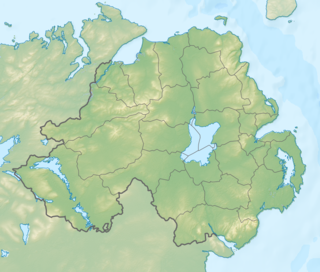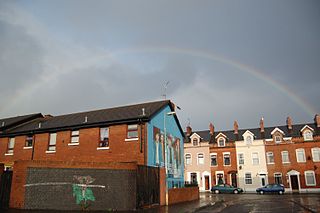The Troubles in Ardoyne lists incidents during the Troubles in the Ardoyne district of Belfast, Northern Ireland.
On 18 November 1975 an Irish Republican Army (IRA) unit nicknamed the Balcombe Street Gang, without warning, threw a bomb into Walton's Restaurant in Walton Street, Knightsbridge, London, killing two people and injuring almost two dozen others.

The Battle of Lenadoon was a series of gun fights over six days from the 9–14 July 1972 between the Provisional IRA and the British Army, having started on Thursday, 9 July 1972 in and around the Lenadoon Avenue area and spreading to other places in Belfast. Loyalist paramilitaries and the Official Irish Republican Army were involved in some of the incidents. 28 people in total were killed in Belfast according to the CAIN: Sutton Index of Deaths. The violence ended a two-week truce between the forces of the British Government and the IRA.
The Provisional IRA's Balcombe Street Gang was a Provisional IRA active service unit (ASU) who carried out a bombing campaign in southern England in the mid-1970s. The majority of their attacks and attempted attacks took place in London and the rest in Surrey, Hampshire and Wiltshire. Between October 1974 and December 1975 they carried out approximately 40 bomb and gun attacks in and around London, sometimes attacking the same targets twice. The unit would sometimes carry out two or more attacks in one day; on the 27 January 1975 they placed seven time bombs in London. On 25 November 1974, they carried out three bomb attacks in the centre of London injuring 20 people. They were eventually caught during the Balcombe Street siege in December 1975, thus ending their 15-month bombing campaign in England. They have been described as "the most violent, ruthless and highly-trained unit ever sent to Britain by the Provisional IRA".
The Rose & Crown Bar bombing was a bomb attack carried out against a Catholic-owned pub in Belfast. The attack was carried out by the loyalist paramilitary group the Ulster Volunteer Force (UVF) just less than two weeks before the start of the Ulster Workers' Council strike of May 1974 which brought down the Sunningdale power sharing agreement and just 15 days before the UVF carried out the Dublin and Monaghan bombings which killed 34 and injured 300 people, the highest casualty rate in a single day during The Troubles in either Ireland or Britain.

The Lichfield gun attack was an ambush carried out by the Provisional IRA (IRA) on 1 June 1990 against three off-duty British soldiers who were waiting at Lichfield City railway station in Staffordshire. The attack resulted in one soldier being killed and two others badly wounded. On the same day a British Army major was killed by the IRA in a gun attack outside his house in Dortmund, Germany.
On 5 April 1975 Irish republican paramilitary members killed a UDA volunteer and four Protestant civilians in a gun and bomb attack at the Mountainview Tavern on the Shankill Road - the heart of loyalist Belfast. The attack was claimed by the Republican Action Force believed to be a covername used by Provisional IRA (IRA) volunteers. Earlier in the day, two Catholic civilians were killed in a bomb attack in a Belfast pub carried out by the Protestant Action Force a name used by the Ulster Volunteer Force to claim some attacks. An elderly Catholic man was shot later the same night by loyalists bringing the death toll to eight for the day.

On 18 February 1991 the Provisional IRA (PIRA) exploded two bombs at London mainline stations, one at Victoria station and the other at Paddington station, killing one person and injuring 38 other people all at Victoria station. It was the IRA's second major attack in London in February 1991 after the Downing Street mortar attack eleven days earlier which was an attempt to wipe out the British War cabinet and the British prime minister John Major. It was also the first IRA attack against a civilian target in England since the 1983 Harrods bombing, marking a strategic change in their bombing campaign in England.

The Inglis Barracks bombing was a bomb attack carried out by the Provisional Irish Republican Army (IRA) on 1 August 1988 on a British Army barracks called Inglis Barracks in Mill Hill, London. The attack killed one soldier, injured nine more and destroyed large parts of the barracks. It was the first IRA attack in England since the 1984 Brighton Bombing.

In the late hours of 3 February and the early hours of 4 February 1973, six men, all of whom were Catholics, were shot and killed in the New Lodge area of north Belfast, four of them were shot dead at the junction at Edlingham Street by British Army snipers, the other two men were shot dead by the Ulster Defence Association (UDA). Irish Nationalists and Republicans believe that collusion took place between the British security forces and Loyalist paramilitaries in the shootings. The six men who were killed became known as "The New Lodge Six".

On the night of 17 March 1978 at around 21:20 a Provisional Irish Republican Army (IRA) unit and a Special Air Service (SAS) unit became engaged in a shoot out in a field in Lisnamuck, near Maghera, County Londonderry, Northern Ireland. The leader of the IRA unit was Francis Hughes who was from Bellaghy, County Londonderry, who at that time was the "most wanted man" in Northern Ireland when a year earlier on 18 April 1977, Hughes, Dominic McGlinchey and Ian Milne were travelling in a car near the town of Moneymore when an RUC patrol car carrying four officers signalled them to stop. The IRA members attempted to escape by performing a u-turn, but lost control of the car which ended up in a ditch. They abandoned the car and opened fire on the RUC patrol car, killing two officers and wounding another, before running off through fields. A second RUC patrol came under fire while attempting to prevent the men fleeing, and despite a search operation by the RUC and British Army (BA) the IRA members escaped.

The Strand Bar Bombing was a gun and bomb attack carried out by the Loyalist Paramilitary organisation Ulster Volunteer Force (UVF) in Belfast in 1975. The blast destroyed most of the building and killed six civilians and injured about 50 more.

The Central Bar bombing was a bomb attack on a pub in the town of Gilford near Portadown in County Down in Northern Ireland on 31 December 1975. The attack was carried out by members of the Irish National Liberation Army (INLA) using the covername "People's Republican Army". Three Protestant civilians were killed in the bombing.
The Official IRA's Belfast Brigade was founded in December 1969 after the Official IRA itself emerged in December 1969, shortly after the beginning of the Troubles, when the Irish Republican Army split into two factions. The other was the Provisional IRA. The "Officials" were Marxist-Leninists and worked to form a united front with other Irish communist groups, named the Irish National Liberation Front (NLF). The Brigade like the pre-split IRA brigade before the split had three battalions, one in West Belfast, one in North Belfast and the Third in East Belfast. The Belfast Brigade was involved in most of the biggest early confrontations of the conflict like the Falls Curfew in 1970, the battles that followed after the introduction of Internment without trial in 1971 and Volunteers joined forces with the Provisional brigade to fight the British Army and UVF during the Battle at Springmartin in 1972. The first Commanding Officer (CO) of the brigade was veteran Billy McMillen who fought during the IRA Border Campaign. Shortly after the death of Official IRA Belfast "Staff Captain" Joe McCann in April 1972, the battalion structure of the brigade was done away with and command centralized under McMillen.
Roy Walsh is a former Provisional IRA volunteer. He was convicted for his part in the IRA's 1973 Old Bailey bombing which injured over 200 people and one person died from a heart attack due to the bombing.
The following is a timeline of Northern Irish conflict actions which took place in the Republic of Ireland between 1969 and 1998. It includes Ulster Volunteer Force bombings such as the Dublin and Monaghan bombings in May 1974, and other Loyalist bombings carried out in the 1970s, 80s & 90s, the last of which was in 1997. These attacks killed dozens of people and injured hundreds more. Also actions carried out by Irish Republicans including bombings, prison escapes, kidnappings, and gun battles between the Gardaí (police) and the Irish Defence Forces against Republican gunmen from the Irish National Liberation Army, the Provisional Irish Republican Army, and a socialist-revolutionary group, Saor Éire. These attacks killed a number of civilians, police, soldiers, and Republican paramilitaries.
The Rossnaree Hotel shooting was an event that took place in the Republic of Ireland on 20 January 1987 under the false pretence of peace talks between the Irish People's Liberation Organisation (IPLO) and the Irish National Liberation Army (INLA). Two gunmen from the newly formed IPLO shot four Volunteers from the INLA, killing two, Thomas "Ta" Power (34) and John O'Reilly (26). Hugh Torney, the leader of the INLA faction, and another INLA Volunteer, Peter Stewart, were both injured in the attack that took place at Rossnaree Hotel in Drogheda, County Louth.

The Red Lion Pub bombing was a bomb attack that happened on 2 November 1971, when a bomb planted by the Provisional IRA's Belfast Brigade exploded in the Red Lion pub in Belfast, killing three people and injuring about 30 others.
The Irish National Liberation Army Belfast Brigade was the main brigade area of the Irish National Liberation Army. The other Brigade areas were in Derry and Armagh with smaller units in Newry, east and west Tyrone and south Fermanagh.
This is a timeline of actions by the Official Irish Republican Army, an Irish republican & Marxist-Leninist paramilitary group. Most of these actions took place as part of a Guerrilla campaign against the British Army & Royal Ulster Constabulary and internal Irish Republican feuds with the Provisional IRA & Irish National Liberation Army from the early 1970s - to the mid 1970s during the most violent phase of "the Troubles" in Northern Ireland.






